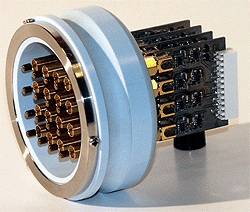Nov 22 2010
Plymouth-oriented Plessey Semiconductors have advanced an Electric Potential Sensor (EPS) that have been devised by the scientists at Sussex University. This unique EPS is capable of generating an electrocardiogram (ECG) by monitoring the fluctuations that occur in the electric field in the heart.
In contrast to the conventional ECG monitors with about 12 electrodes fixed to the skin using conductive gel, the EPS checks the activity of heart by attaching a sequence of sensors over the chest, or simply by using two sensors located in the middle of the heart, for instance, holding one sensor in one hand.
 Electric Potential Sensor
Electric Potential Sensor
The EPS also identifies deviations in the electric field occurring in body due to muscle actions and thus by positioning the sensors within particular muscles, control of artificial limbs can be regulated or can be deployed for evaluating the body movements the athletes during sport.
These sensors located on temples or on a pair of glasses, help tracking the movement of the eye, permitting the users to regulate computers with their eye while playing games or aid disabled people.
The EPS is highly sensitive and can identify the bodily actions within the electric field of the Earth, even across a solid wall, thus it determines the presence of people even without entering the room.
Prof Robert Prance, of Sussex University devised the EPS for sensitively monitoring electric fields avoiding re-validation. According to Dr Keith Strickland, technology director at Plessey, the device has the potential to determine the movements that occur even 50cm away and does not require any sort of energy form the circuit for measuring the electric filed.
Plessey is working towards advancing the university’s modeled systems and fabricate silicon-enabled sensors for use in computer chips using improved software and microcontrollers. Strickland stated that for achieving this, the sensors need to be detached from electrical fields and they are now facing these isolation problems from other circuits surrounding it.
Plessey also aims to develop multi-element sensing sequences to generate 3D video imaging technology for producing a pixel data from each sensor for more improved applications.
Source: http://www.plesseysemiconductors.com